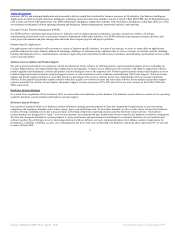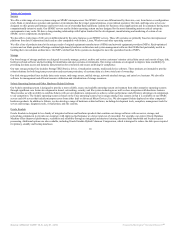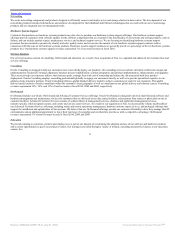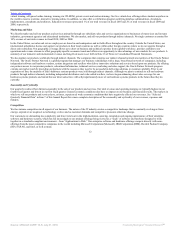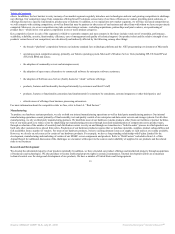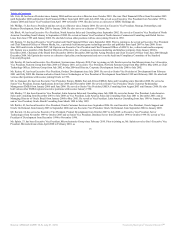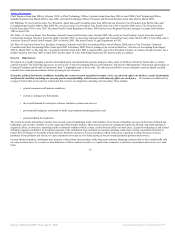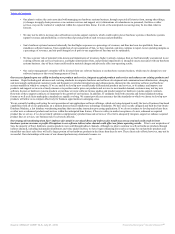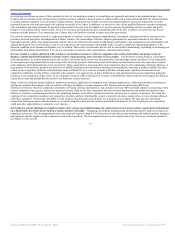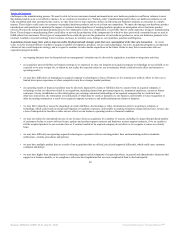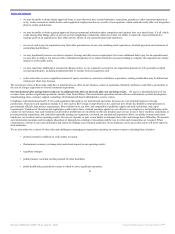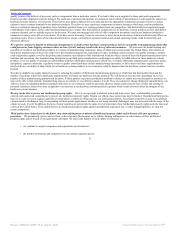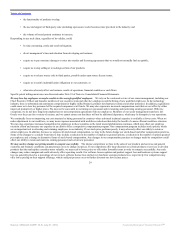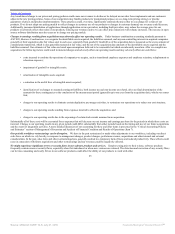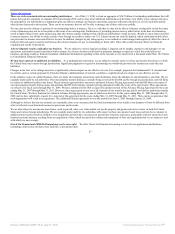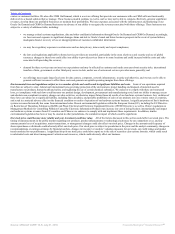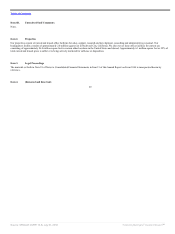Oracle 2009 Annual Report Download - page 23
Download and view the complete annual report
Please find page 23 of the 2009 Oracle annual report below. You can navigate through the pages in the report by either clicking on the pages listed below, or by using the keyword search tool below to find specific information within the annual report.
Table of Contents
are reducing our reliance on some of these partners for sales of our hardware products, are modifying our approach and timing to the manufacturing of our
products and are altering certain of Sun’s legacy business practices with these channel partners, which could result in reduced demand from the channel partners
or certain customer segments serviced by these channel partners. Some hardware systems revenues from channel partners may not be replaced by revenues
generated from our own sales personnel or be replaced as quickly as we expect. In addition, we may not be able to hire qualified hardware systems salespeople,
sales consultants and other personnel for our direct sales model at the rate or in the numbers we need to generate the hardware systems revenues and profit
margins we have projected for future periods. Even if we can meet our hiring needs, these salespeople may not be able to achieve our sales forecasts for our
hardware systems business. If we experience any of these risks, our hardware systems revenues or profits may decline.
Our software indirect channel network is comprised primarily of resellers, system integrators/implementers, consultants, education providers, internet service
providers, network integrators and independent software vendors. Our relationships with these channel participants are important elements of our software
marketing and sales efforts. Our financial results could be adversely affected if our contracts with channel participants were terminated, if our relationships with
channel participants were to deteriorate, if any of our competitors enter into strategic relationships with or acquire a significant channel participant or if the
financial condition of our channel participants were to weaken. There can be no assurance that we will be successful in maintaining, expanding or developing our
relationships with channel participants. If we are not successful, we may lose sales opportunities, customers and revenues.
If we are unable to compete effectively with existing or new hardware systems or software competitors, the results of operations and prospects for our
business could be harmed through fewer customer orders, reduced pricing, lower revenues or lower profits. Our hardware systems business will compete
with, among others, (i) systems manufacturers and resellers of systems based on our own microprocessors and operating systems and those of our competitors,
(ii) microprocessor/chip manufacturers and (iii) providers of storage products. Our entrance into the hardware systems business may also cause us to compete
with companies who historically have been our partners. These competitors in most cases have more experience than we do in managing a hardware business. A
large portion of our hardware products are based on our SPARC microprocessor and Solaris operating system platform, which has a smaller installed base than
certain of our competitors’ platforms and which may make it difficult for us to win new customers that have already made significant investments in our
competitors’ platforms. Certain of these competitors also compete very aggressively on price. Furthermore, Sun experienced increased competition during the
pendency of our acquisition of Sun. A loss in our competitive position could result in lower revenues or profitability, which could adversely impact our ability to
realize the revenue and profitability forecasts for our hardware systems business.
Many vendors develop and market databases, middleware products, application development tools, business applications, collaboration products and business
intelligence products that compete with our software offerings. In addition, several companies offer business process outsourcing (BPO) and
Software-as-a-Service (SaaS) as competitive alternatives to buying software and hardware, and customer interest in BPO and SaaS solutions is increasing. Some
of these competitors have greater financial or technical resources than we do. Our competitors that offer business applications and middleware products may
influence a customer’s purchasing decision for the underlying database in an effort to persuade potential customers not to acquire our products. We could lose
customers if our competitors introduce new competitive products, add new functionality, acquire competitive products, reduce prices or form strategic alliances
with other companies. Vendors that offer BPO or SaaS solutions may persuade our customers not to purchase our products. We may also face increasing
competition from open source software initiatives, in which competitors may provide software and intellectual property for free. Existing or new competitors
could gain sales opportunities or customers at our expense.
Our hardware systems offerings are complex products. If we cannot successfully manage the required processes to meet customer requirements and demand
on a timely basis, the results of our hardware systems business will suffer. Designing, developing, manufacturing and introducing new hardware products are
complicated processes. The development process is uncertain and requires a high level of innovation from both systems hardware and software product designers
and engineers and the suppliers of the components used in these products. The development process is also lengthy and costly. Once a new hardware product is
developed, we face several
19
Source: ORACLE CORP, 10-K, July 01, 2010 Powered by Morningstar® Document Research℠


